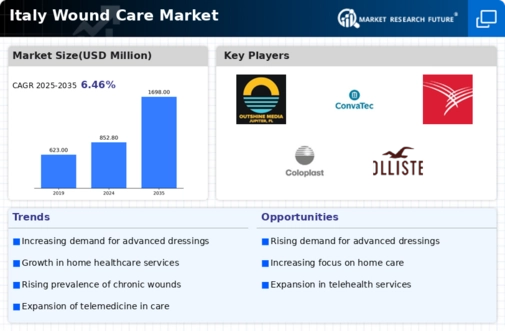Growth in Surgical Procedures
The expansion of surgical procedures in Italy significantly influences the wound care market. With advancements in surgical techniques and an increase in elective surgeries, the demand for effective wound management solutions is on the rise. In 2025, it is estimated that over 1.5 million surgical procedures will be performed in Italy, leading to a corresponding increase in postoperative wound care requirements. The wound care market is adapting to this surge by offering a variety of products designed to promote healing and prevent complications. The market for surgical wound care products is projected to grow at a CAGR of 6% through 2027, reflecting the ongoing need for innovative solutions in this area. This growth in surgical procedures highlights the importance of effective wound care management in improving patient outcomes.
Rising Awareness of Wound Care
There is a growing awareness of the importance of proper wound care among healthcare professionals and patients in Italy. Educational initiatives and campaigns aimed at promoting best practices in wound management are becoming more prevalent. This heightened awareness is likely to drive demand for advanced wound care products and services. The wound care market is witnessing an increase in the adoption of specialized training programs for healthcare providers, which enhances their ability to manage wounds effectively. As a result, the market is expected to see a growth rate of approximately 5% annually as more healthcare facilities implement comprehensive wound care protocols. This trend indicates a shift towards a more informed approach to wound management, ultimately benefiting patient care.
Government Initiatives and Funding
Government initiatives aimed at improving healthcare infrastructure in Italy are significantly impacting the wound care market. Increased funding for healthcare services, particularly in the realm of chronic disease management, is facilitating the development and distribution of advanced wound care products. The Italian government has allocated over €200 million for healthcare improvements in 2025, which includes investments in wound care technologies and training programs for healthcare professionals. The wound care market stands to benefit from these initiatives as they promote the adoption of innovative solutions and enhance patient access to quality care. This supportive regulatory environment is likely to drive market growth, with an expected increase in the availability of advanced wound care products across healthcare facilities.
Increasing Incidence of Chronic Wounds
The rising prevalence of chronic wounds in Italy is a critical driver for the wound care market. Factors such as an aging population, which is projected to reach 23% of the total population by 2030, contribute to this trend. Chronic conditions like diabetes and venous ulcers are becoming more common, necessitating advanced wound care solutions. The wound care market is responding to this demand by developing specialized products that cater to the needs of patients with chronic wounds. In 2024, the market for chronic wound care products in Italy is expected to exceed €500 million, indicating a robust growth trajectory. This increasing incidence of chronic wounds underscores the need for effective management strategies and innovative products, thereby propelling the wound care market forward.
Technological Advancements in Wound Care
Technological innovations are playing a pivotal role in shaping the wound care market. The introduction of advanced materials and smart technologies, such as bioactive dressings and telemedicine solutions, is revolutionizing wound management practices in Italy. These innovations not only enhance healing rates but also improve patient monitoring and care efficiency. The wound care market is projected to experience a growth rate of 7% annually as these technologies become more widely adopted. Furthermore, the integration of artificial intelligence in wound assessment and treatment planning is expected to streamline processes and reduce healing times. This technological advancement signifies a transformative shift in how wounds are treated, ultimately leading to better patient outcomes.
















Leave a Comment